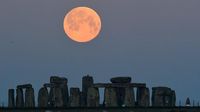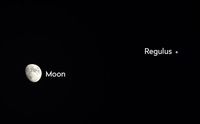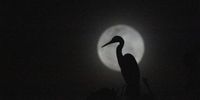As April unfolds, stargazers in the Tri-State area are in for a celestial treat with the arrival of the Pink Moon and the Lyrid meteor shower. The Pink Moon will shine brightly in the night sky on Saturday, April 12, 2025, marking the first full moon of spring, a season that began with the vernal equinox on March 20. This full moon, although not actually pink in color, is named after the early blooming ground phlox flowers, which herald the arrival of spring.
The Pink Moon will reach its full phase at 8:23 p.m. EDT on April 12, just an hour after it rises in the eastern sky around 7:23 p.m. local time. The event is particularly special this year as it coincides with the weekend, allowing many to enjoy the view without the constraints of a workday. According to the Old Farmer's Almanac, the name "Pink Moon" reflects the seasonal changes as it is associated with the first flowers to bloom in spring.
While the moon will not change color, it will appear larger and more vibrant during moonrise due to a phenomenon known as the "moon illusion." This optical illusion makes the moon look bigger when it is near the horizon compared to when it is high in the sky. For the best viewing experience, find an unobstructed location facing east and let your eyes adjust to the dark.
This month is also marked by the Lyrid meteor shower, which is one of the oldest known meteor showers, with records dating back over 2,700 years to 687 BC. The Lyrids are expected to peak from the night of April 21 into the early morning hours of April 22. Stargazers can expect to see up to 15 meteors per hour under Indiana's dark skies. The meteor shower is active from April 17 to April 26, but the best time to catch a glimpse of these shooting stars will be after 9:30 p.m. local time on the peak night.
For those planning to watch the Lyrids, the National Weather Service forecasts mostly clear skies on the night of the Pink Moon, with temperatures dropping to around 40 degrees Fahrenheit. On Sunday, April 13, partly cloudy skies are predicted with a low of around 55 degrees. This weather will provide an excellent backdrop for both the moon and the meteors.
In addition to the Pink Moon and the Lyrids, other astronomical events are set to occur throughout April. On April 1 and 30, Jupiter will be visible with the crescent moon in the western sky after sunset. On April 24-25, a grouping of Venus, Saturn, and the crescent moon will be visible low in the east before dawn. Mercury will also be visible below them for those with a clear view of the horizon.
April's full moon is also known by other names, including the Frog Moon, the Sugar Maker Moon, and the Breaking Ice Moon, which reflect various cultural significances tied to the season. Native American tribes used these names to track seasonal changes, and the full moon's timing is also significant for determining the date of Easter, which falls on April 20 this year, the Sunday following the Pink Moon.
As spring progresses, the next full moon, known as the Flower Moon, is expected to illuminate the night sky on May 12, 2025. This full moon will also bring its own set of celestial events, inviting stargazers to continue exploring the wonders of the night sky.
For those looking to enhance their stargazing experience, several free astronomy apps can assist in locating stars, planets, and constellations. Apps like SkyView Lite, Star Walk 2, and NASA's official app are available for both iPhone and Android users.
As the Pink Moon rises, let it serve as a reminder of the beauty of the natural world and the wonders that lie beyond our planet. Whether you're an experienced astronomer or a casual observer, the skies this April promise to be a sight worth watching.









